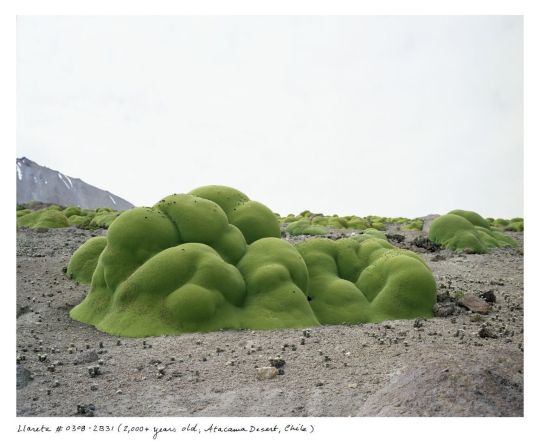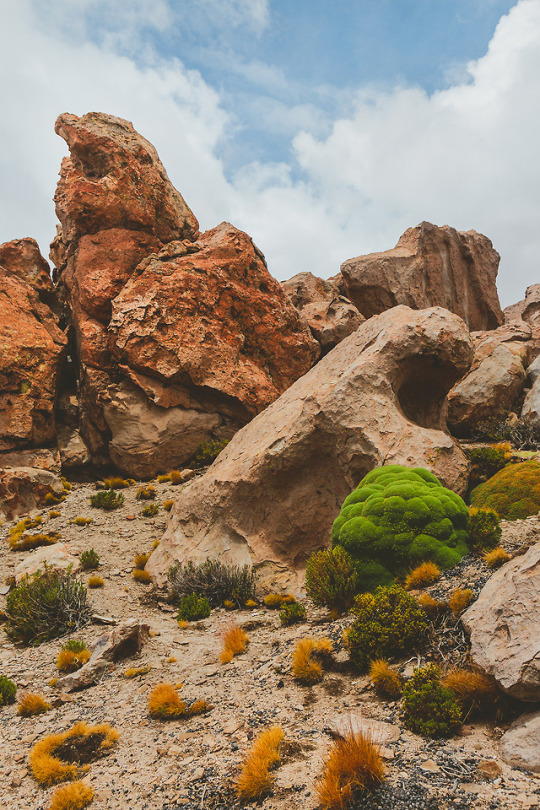#Azorella compacta
Explore tagged Tumblr posts
Video
llareta / azorella compacta by chris malebran Via Flickr:
3 notes
·
View notes
Photo



Artist Rachel Sussman photographs the oldest living things in the world before they disappear (top pic). This is a plant called yareta (Azorella compacta, "Llareta" in Spanish), a tiny flowering plant native to the high deserts of Peru, Bolivia, northern Chile, & western Argentina found at 9,600 to 13,500 feet. Yareta is an evergreen perennial with tiny pink or lavender flowers. Growth rate has been recently estimated at approximately 1.5 cm per year. Many yaretas are over 3,000 years old.
*Wikipedia entry
#oldest living things#Rachel Sussman#yareta#Azorella compacta#horticulture#naturalist#high desert flora
20 notes
·
View notes
Photo

Azorella compacta, growing at altitudes between 3000 and 4500 m. Most of these are 3000 years old.
1 note
·
View note
Text
Yareta, une plante qui vit plusieurs milliers d'années
Nouvel article publié sur https://www.2tout2rien.fr/yareta-une-plante-qui-vit-plusieurs-milliers-dannees/
Yareta, une plante qui vit plusieurs milliers d'années

#âge#andes#argentine#Azorella compacta#bolivie#chili#longévité#montagne#mousse#perou#plante#plateau#rocher#vidéo#vieillissement#Yareta#imxok#nature#voyage
0 notes
Text
I want u all to share in this knowledge with me that if the Last City is anywhere near the atacama desert or its neighboring mountains then theres probably these little guys (azorella compacta, or llareta). and thats beautiful.


#destiny 2#i am an Azorella compacta stan for life#yes i have too much interest in south america flora
159 notes
·
View notes
Text

Yareta (Azorella compacta) in Bolivia (elevation of 14,000 ft.).
This may look like a moss, but it isnt! This is a broad-leafed plant in the carrot family, Apiaceae.
These plants can grow to bve over 3000 years old. This large specimen may be over 1000 years old.
photographs by Mark Dwyer
source: The Fabulous Weird Trotters
https://bit.ly/4dbg0bh
398 notes
·
View notes
Text
Yareta
Azorella compacta
Azorella translates into small and dry, while compacta translates into compacted.
Family: Apiaceae (Carrot Family)
Fun Fact: They can be up to 2,000 years old, and can be so compact you can stand on top of it with no ill effect. (Source)
Habitat: They are native to mountainous regions from southern Peru to northern Chile and southwestern Bolivia.
1 note
·
View note
Text



Yareta (Azorella compacta) in Bolivia (elevation of 14,000 ft.).
This may look like a moss, but it isnt! This is a broad-leafed plant in the carrot family, Apiaceae.
These plants can grow to bve over 3000 years old. This large specimen may be over 1000 years old.
Photographs by Mark Dwyer.
0 notes
Text

llareta / Azorella compacta, one of the oldest plants in the world — some are over 2000-3000 years old. Photograph by Rachel Sussman.
34 notes
·
View notes
Photo

Staying Alive in the Atacama
The Llareta (or yareta) plant (Azorella Compacta) of the Atacama Desert is well known for being one of the longest living organisms on the planet. Some of the larger specimens have been calculated to be approximately 3000 years old. While this is, by itself, a magnificent feat, the llareta holds some of it's most wonderful characteristics close. Literally.
Botanically speaking, these plants are masters at taking advantage of their desert environments, flaunting adaptations on par with the cactus'. As it's scientific name might suggest, llareta is composed of stems, often very long in older plants, that support a rosette of leaves that are tightly packed together. This type of compact growth is a valuable adaptation in a desert climate as it reduces the surface area to volume ratio – a smart move when you are trying to reduce evaporation.
When smaller stems are blocked from the sun, they die back, creating packing material that makes the interior of llareta very dense. It's so dense, in fact, that they can bear the full weight of a person seemingly without harm. But the dense core of these cushions provide a very helpful service for the plant. Not only is it a perfect sponge for holding water during times of drought, it is also a great way to keep the interior of the plant cool during the hottest parts of the day.
The plant's habitat preferences also help to reduce water loss. New plants often take advantage of small cracks in the rock surfaces in the desert (as shown in the picture below). These cracks provide perfect microclimates that offer cooler temperatures in hot weather, warmer temperatures in cold weather, more water during drought, and shelter from the winds that can blast through the open spaces. It also appears that the fringes of established plants create new microclimates also suitable for new, baby llareta.
Llareta has also found a niche in another aspect of life in the Atacama; humans have been using the plant for centuries, up to the present. The dense core is perfect for fires and even creates a flammable resin that produces a slow, nearly smokeless fire. Because of these valuable traits, it was used in mining operations and to power trains. However, the desirability of the plant has also caused its decline, and llareta is now an endangered species. This is particularly troubling because llareta also has some promising medicinal properties. Several studies, dating as far back as 1982 have shown that it is effective in treating diabetes caused by obesity.
Further Reading: Wickens, G. E. “Llareta (Azorella Compacta, Umbelliferae): A review”. Economic Botany. April-June 1995, Volume 49, Issue 2, pp 207-212 Photo Courtesy of Magnus von Koeller
Colter
#llareta#yareta#Azorella Compacta#atacama#plant#desert#succulent#water#the earth story#microclimate#niche#botany#biology
2K notes
·
View notes
Photo

Azorella compacta
3,000 year old Yareta plant
(via)
752 notes
·
View notes
Photo

Somewhere in Bolivia
That green bubbly looking guy is Yareta or Llareta (Azorella compacta) — a flowering plant native to the high altitude regions (10,000' - 15,000') of the Andes in Peru, Bolivia, northern Chile, and western Argentina. They often live as long as 3,000 years, making some specimens, among the oldest living organisms on the planet.
Instagram Prints
#landscape#photographers on tumblr#Bolivia#South America#desert#nature#outdoors#travel#wanderlust#Yareta#Llareta#Apiaceae#Azorella compacta#lensblr#orignal photgraphers#Brian Stowell#brianstowell
1K notes
·
View notes
Text

Azorella compacta growing at place 4,750m/15,600ft in the Chilean Andes
Source: Cactus Explorer
192 notes
·
View notes
Text

Yareta (Azorella compacta)
2K notes
·
View notes
Photo




Llareta plant (Azorella compacta) - high Bolivian Andean plateau (altiplano), near the Ollague volcano. Some of these evergreen plants are 3000 years old, being amongst the oldest organisms on Earth.
11 notes
·
View notes
Photo

Green Fuzzy Rocks Yareta Plant - Azorella Compacta 15,000 feet (5,000 meters) Arequipa Province, Peru 2001 #lichen #highelevation #arequipa #peru #landscape #travelphotography #travel #southamerica #green #©lauraquick https://www.instagram.com/p/Bw2LS3rnELr/?utm_source=ig_tumblr_share&igshid=sheqeplomn8t
#lichen#highelevation#arequipa#peru#landscape#travelphotography#travel#southamerica#green#©lauraquick
6 notes
·
View notes
